Contents
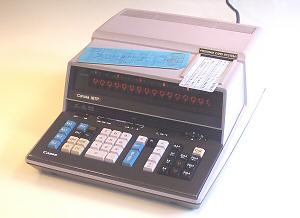
Contents |

|
| Canon "Canola" Model 167P, 1971 |
In July 1963, the Canon Camera Company of Japan completed what was possibly the first-ever prototype of a ten-key all-transistor electronic calculator (the Canola 130) as a first step into the business equipment market. Canon's management had "doubts that a camera company could make a commercial success of an electronic calculator", and did not proceed with manufacture until after Friden and Sharp had introduced similar machines in 1964. Canon thus "forfeited the honour" of marketing the first 10-key all-electronic calculator. (Source: Canon company history at www.canon.com)
Canon's managers need not have worried. Their solid, reliable, and easy-to-use business calculators found ready acceptance in offices and factories in most countries of the world. The new calculator division out-lasted all of the mechanical calculator companies and is still in business today, almost 50 years after its rather tentative beginnings.
This page is concerned primarily with Canon's early desktop machines, although the company also built (and continues to build) an extensive range of portable and pocket calculators, and a range of business-oriented printing calculators. The machines below are typical of those sold in Australia during the first half of the 1970s, and have been selected to show the steady progress in electronic circuitry, keyboards, and display systems. Canon desktop calculators built since the mid-70s do not really qualify as museum pieces, since most of them are still in everyday use!
Many of the Canon's circuit boards and plastic components carry a date code in the form YY-MM-DD, where the years are counted in the traditional Japanese method based on the reign of the current emperor. Year 1 of Emperor Showa (Hirohito) was 1926, so the year of manufacture can be found by adding 1925 to the first two digits. For example, 45.1.20 is the 20th of January 1970.
Click on the photos below for larger versions, or follow the links for further details.
Canon's early IC-based calculators were developed in conjunction with Texas Instruments, a major American supplier of integrated circuit technology. The first two digits of the model numbers generally represent the number of digits in the display.
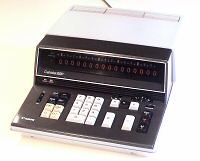 Canon "Canola" Model 162P, S/N 789036
Canon "Canola" Model 162P, S/N 789036
Functions: ASMD, 2 memories
Programming: 32 steps, fixed program
Technology: Bipolar DTL-SSI on 4 boards, delay line memory
Display: 16 digits, Nixie tube
Dimensions: 310W x 395D x 150H, weight 6.2kg
Manufactured: Japan, manual dated September 1969
Canon's first calculator, the Model 130, was introduced in 1964. It was a 13-digit 10-key machine using discrete-transistor logic. The 16-digit IC-based 160-series followed soon after.
This Model 162P is a basic 4-function machine built using general-purpose small-scale integrated circuit (SSI) chips. The machine has a constant function and two internal memory registers, implemented using a mechanical (ie, acoustic) delay line from NEC. One memory is directly accessible from the keyboard, while the other automatically accumulates the results of successive multiplications and divisions.
The circuitry of the 162P uses over 100 separate IC chips occupying four circuit boards, each about 280x125mm, plus a considerable amount of discrete-component logic. The chips are from an early Texas Instruments "Semiconductor Networks" (SN4500) series, using diode-transistor (DTL) logic. (The "later" and more common SN54/74 TTL chips were actually made from 1964, but supplies were restricted to the US military. They did not appear in Canon's calculators until 1970). The display uses 16 multiplexed Nixie tubes, while the keyboard uses glass reed switches operated by magnets on the ends of the keystems.
The "P" suffix indicates a programming capability, which is rather limited by today's standards. When the manual talks of "inserting a program card into the machine", it actually means removing the case and plugging in a full-size circuit board, onto which a technician has soldered a diode matrix to represent the 32 program steps that you require.
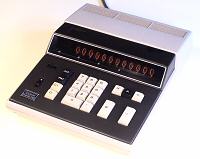 Canon "Canola" Model 1210, S/N 481699
Canon "Canola" Model 1210, S/N 481699
Functions: ASMD, constant, 1 memory
Technology: 69 DTL-SSI on 2 boards, delay line memory
Display: 12 digits, Nixie tube
Dimensions: 265W x 335D x 100H, weight 4.0kg
Manufactured: Japan, May 1970
Model 1210 is a (relatively) compact 12-digit machine with a constant function and a single accumulating memory. The circuitry uses 68 DTL-SSI chips from the Texas Instruments SN3900 and SN4500 series, and a single TTL SN7400. The machine has a reed-switch keyboard and a 12-digit Nixie tube display.
 Canon "Canola" Model 164P, S/N 340071
Canon "Canola" Model 164P, S/N 340071
Functions: ASMD, square root, 4 memories
Programming: Learn or punched card entry
Technology: 156 DTL-SSI on 7 boards, delay line memory
Display: 16 digits, Nixie tube
Dimensions: 310W x 395D x 165H, weight 7.6kg
Manufactured: Japan, December 1970
The Canon 164P is a larger and more elaborate user-programmable machine with four memory registers and a square root function. Two separate programs can be entered and checked from the keyboard, or prepared off-line on miniature pre-punched cards and loaded through the internal photo-electric card reader. (The cards are IBM-standard 7-bit x 40-column, measuring 187x57mm).
The circuitry uses 156 DTL-SSI chips from the Texas Instruments SN3900 and SN4500 series, with about 100 discrete transistors and over 500 diodes. The reed-switch keyboard and Nixie tube (actually Hitachi CD-71) display are similar to the earlier machines.
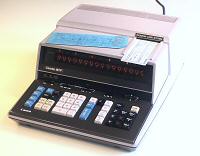 Canon "Canola" Model 167P, S/N 101256
Canon "Canola" Model 167P, S/N 101256
Functions: ASMD, square root, 7 memories
Programming: 130 steps, Learn or punched card entry
Technology: 10 LSI, 99 DTL-SSI on 6 boards
Display: 16 digits, Nixie tube
Dimensions: 310W x 395D x 165H, weight 7kg
Manufactured: Japan, manual dated September 1971
The Canon 167P from 1971 was billed as a "personal mini-computer... a machine to bridge the gap between a full-scale computer and an electronic calculator".
The machine extends the programming functions of the 164P by adding a set of computer-like conditional jump instructions. The program memory can be organised as two independent areas of 50 and 80 steps, a single area of 130 steps, or extended indefinitely with punched-card overlays. There are 7 accessible memory registers for accumulation or temporary storage.
The internal circuitry is based on a set of 5 MOS-LSI chips from Texas Instruments (TMC 1761,3,4,5,6) and 5 MOS ROMs for the firmware. These are supported by 99 DTL-SSI chips from the SN3900 and SN4500 series, with about 70 discrete transistors and numerous diodes.
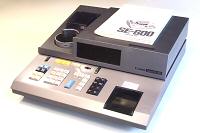 Canon "Canola" Model SE-600, S/N 400058
Canon "Canola" Model SE-600, S/N 400058
Functions: ASMD, square root, 100 memories
Programming: 600 steps, subroutines, punched card entry
Technology: 385 DTL/TTL SSI chips on 14 boards, MOS shift register memory
Display: 3 digit program counter, 16+5 digit printer
Dimensions: 405W x 530D x 190H, weight 21.5kg
Manufactured: Japan, manual dated November 1971
The Canola SE-600 programmable calculator from 1971 probably represents the ultimate development of the second-generation DTL-SSI calculator technology.
As a keyboard-driven desk calculator, the SE-600 is little more than a basic 4-function machine with square root and two memory registers. It has an internal dot-matrix printer which records all entries, operations, and results, but there is no separate numeric display.
As a programmable machine, its power comes from its computer-like ability to execute conditional branching and nested subroutines, and from its enormous (for the time) complement of one hundred memory registers, each capable of holding a 16-digit BCD number or 6 program steps.
The circuitry of the SE-600 uses almost 400 DTL ICs from the standard Texas Instruments families, with a small number of TTL and "special" chips. The mechanical delay-line memory of the earlier machines has been replaced with a solid-state version using Intel 1404 1024-bit MOS shift registers. The machine runs from a 2-phase clock at 1.3MHz, and calculates a square root in around 40mS.
A detailed (but still unfinished) description of the construction, operation, and programming of the Canon SE-600 is available in the Technical Section.
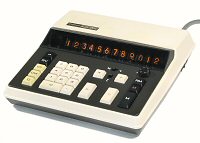 Canon "Canola" Model L121, S/N 603347
Canon "Canola" Model L121, S/N 603347
Functions: ASMD, 1 memory
Technology: 4-chip MOS-LSI by Texas Instruments
Display: 12 digits, miniature Nixie tube
Dimensions: 235W x 245D x 75H, weight 2.2kg
Manufactured: Japan, June 1971
Canon's first all-LSI calculator was a brick-sized portable machine from 1970 which was rather optimistically called the "Pocketronic". This compact L121 desktop calculator followed in 1971, offering similar functions to the Canola 1210 (above) in about half the volume and weight.
The L121 used a new set of four MOS-LSI chips from Texas Instruments (TMC 1733,53,54,1807), with about 30 transistors and a handful of discrete components. A brochure for the L121 claims that the four chips contain "a total of 15,000 elements, twice as many as you find in conventional calculators". The machine has a reed-switch keyboard and a 12-digit Nixie tube display similar to the previous models.
The L121 includes constant and roundoff functions, a single
(non-accumulating) memory, and a rotary switch for 0 to 6 decimal
places. An unusual feature is a backspace key to allow correction
of mistakes on entry. The machine has a detachable power cord and
a built-in retractable carrying handle.
L121 circuit board (32kb)
 Canon "Canola" Model L100S, S/N 302805
Canon "Canola" Model L100S, S/N 302805
Functions: ASMD, constant
Technology: Single-chip MOS-LSI (TMS-0106)
Display: 10 digits, 7-segment neon panel
Dimensions: 185W x 240D x 70H, weight 1.6kg
Manufactured: Japan, October 1972
In just 16 months between the introduction of the L121 and this
L100S, the processor circuitry was reduced from 4 MOS-LSI chips to
just one (a TMS0106), and the individual Nixie display tubes were
replaced with a single flat-panel display (Hitachi H-1813A) similar to
the Burroughs Panaplex. Assembly costs were further reduced by using
hybrid modules to drive the high-voltage display, rather than the
previous discrete transistors. The reed-switch keyboard has a constant
key and slide switches for deciimal places and roundoff, but there
is no memory. Operation is quite conventional with no surprises.
L100S internal view (29kb)
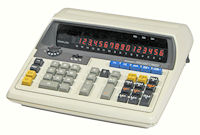 Canon "Canola" Model L1630, S/N 400481
Canon "Canola" Model L1630, S/N 400481
Functions: ASMD, percent, constant, 3 memories
Technology: Five-chip MOS-LSI (Hitachi)
Display: 16 digits, 7-segment neon panel
Dimensions: 260W x 290D x 95H, weight 2.9kg
Manufactured: Japan, April 1973
This Canon L1630 from early 1973 is a 16-digit machine with square root and percentage functions and three memory registers. The five push-button switches at the top right of the keyboard select various automatic memory functions, including item counts, summation of products, and summation of squares for statistical calculations.
The L1630 uses a 5-chip processor from Hitachi, with the board
locations labelled CONT, DATA, ROM, SR, and DIS. The display is a
17-digit gas discharge panel (Hitachi H-1873), with the leftmost
digit used for minus and error indication. The display is driven by
four high-voltage hybrid modules, with separate neon indicators for
over-range and the three memory registers. The keyboard uses glass
reed switches and latching push-buttons, with a rotary switch to set
the display for 0 to 12 decimal places, or full floating-point mode.
L1630 internal view (main board)
L1630 internal view (keyboard)
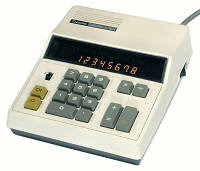 Canon "Canola" Model L800, S/N 400964
Canon "Canola" Model L800, S/N 400964
Functions: ASMD, constant
Technology: Single-chip MOS-LSI (TMS-0105)
Display: 8 digits, 7-segment neon panel
Dimensions: 160W x 200D x 65H, weight 1.4kg
Manufactured: Japan, May 1973
The L800 is a very basic 4-function 8-digit machine using a Texas Instruments TMS-0105 processor and a Hitachi H-1893 gas-discharge display panel. The internal construction is similar to the L100S above.
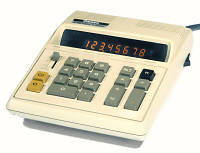 Canon "Canola" Model L802, S/N 412594
Canon "Canola" Model L802, S/N 412594
Functions: ASMD, constant, percent
Technology: Single-chip MOS-LSI (TMS-0128)
Display: 8 digits, 7-segment neon panel
Dimensions: 165W x 215D x 65H, weight 1.2kg
Manufactured: Japan, January 1974
Having reduced the desktop calculator to the bare minimum with the L800, Canon gradually began to re-introduce more advanced functions. This L802 from 1974 uses a new Texas Instruments TMS-0128 processor which includes a percentage function.
A more significant change is the introduction of an elastomeric keyboard to replace the reed switches used in all of the previous models. Instead of magnets to operate the sealed glass switches, the ends of the new keys are fitted with flexible conductive rubber buttons. The buttons are pressed down onto adjacent gold-plated contacts on a circuit board, thus bridging the contacts and providing an electrical signal. The keyboard is permanently connected to the CPU board by a 15-way flexible ribbon. The internal construction is otherwise similar to the L100 and L800 above.
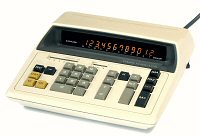 Canon "Canola" Model L1210, S/N 410436
Canon "Canola" Model L1210, S/N 410436
Functions: ASMD, square root, percent, 1 memory
Technology: Two-chip MOS-LSI by Texas Instruments
Display: 12 digits, 7-segment neon panel
Dimensions: 235W x 255D x 80H, weight 2.0kg
Manufactured: Japan, February 1974
The Canon L1210 from 1974 is a capable 12-digit machine which returns to the rounded case styling used on the earlier L1630 (above). It provides constant, square root, and percentage functions, and has a single memory register which can be set for automatic accumulation of products. A slide switch selects 0 to 6 decimal places or full floating-point operation.
The internal construction is similar to the L802, with a
gas-discharge display panel and a permanently-connected elastomeric
keyboard. The extra digits and extra functions required an additional
high-voltage driver module and a return to a two-chip processor
(Texas Instruments TMS-0201 and 0231).
L1210 internal view (30kb)
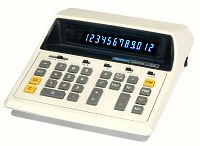 Canon "Canola" Model L1214, S/N 619763
Canon "Canola" Model L1214, S/N 619763
Functions: ASMD, square root, percent, count, 1 memory
Technology: Single-chip MOS-LSI (HD38401A), battery powered
Display: 12 digits, 7-segment blue fluorescent panel
Dimensions: 185W x 225D x 70H, weight 0.8kg (plus batteries)
Manufactured: Japan, January 1975
The Canon L1214 extends the capabilities of the previous models with business-oriented item count and mark-up functions.
This 1975 model introduced significant internal changes, with the previous Texas Instruments processors replaced with Hitachi (HD38401A), and the neon display panels replaced with vacuum fluorescent displays (VFDs). The low-voltage VFD display eliminated all of the complex driver circuitry and reduced the power consumption to just 950mW, enabling operation from 4 internal C-size batteries. The keyboard was also simplified, with the elastometic buttons formed into a continuous sheet which also served as the key return springs.
The internal view shows the display module, its power supply, and the processor chip on the rear board, with the keyboard PCB and keysheet at the front. The row of slider switches across the top of the keyboard operate directly on the contacts on the PCB. The two boards are permanently interconnected by a row of rigid soldered pins. The entire assembly is mounted to the underside of the top section of the case.
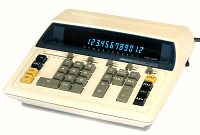 Canon "Canola" Model L1217, S/N 452171
Canon "Canola" Model L1217, S/N 452171
Functions: ASMD, square root, percent, count, 1 memory
Technology: Single-chip MOS-LSI (HD37401A)
Display: 12 digits, 7-segment blue fluorescent panel
Dimensions: 235W x 255D x 80H, weight 1.7kg
Manufactured: Japan, November 1976
The L1217 from 1976 has exactly the same functions as the L1214,
but in a slightly larger mains-powered case. The main board and power
supply are mounted in the bottom section of the case, and attached to
the keyboard PCB with three plug-and-socket connectors. A later
version of the L1217 has the keyboard leads permanently soldered
to the main board.
L1217 internal view (28kb)
Canon's early portable and pocket calculators were developed in conjunction with Texas Instruments. Joerg Woerner's Datamath Calculator Museum has details of most of these early calculators and their internal chipsets in the section "Calculators related to Texas Instruments".